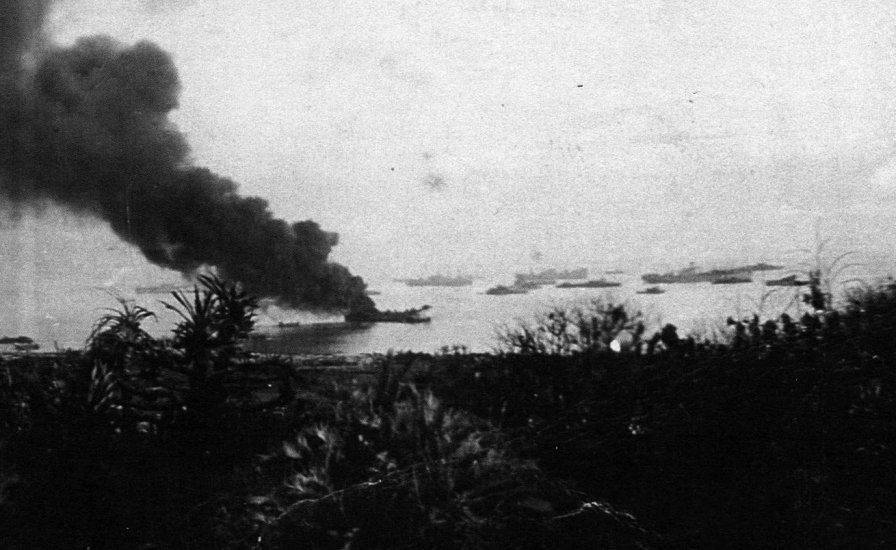Steve Glover/LST 808

She had collided with APA 62 USS Berrien on May 11, damaging the APA.
| Main Page |
Steve Glover/LST 808 |
||||
| Click here for Steve Glover's pictures | LST 1031 replaced by 808 | ||||

|
|||||
| LST 808 burns at Ie Shima
May 18, 1945 after being hit by a torpedo. She was later beached and was
destroyed by a Kamikaze on May 20, 1945.
She had collided with APA 62 USS Berrien on May 11, damaging the APA. |
|||||
(light) - 2' 4" fwd, 7' 6" aft
(sea-going) 8' 3" fwd, 14' 1" aft
(landing) 3' 11" fwd, 9' 10" aft (landing w/500
ton load)
Speed 12 kts. (maximum)
Endurance 24,000 miles @ 9kts. while displacing 3960 tons
Complement
(2-boat davits) 7 officers, 104 enlisted
Troop Accommodations
(2-boat davits) 16 officers, 147 enlisted
Boats 2 LCVP
Cargo Capacity (varied with mission - payloads between 1600 and
1900 tons)
Typical loads
One Landing Craft Tank (LCT), tanks, wheeled and tracked vehicles, artillery, construction equipment and military supplies. A ramp or elevator forward allowed vehicles access to tank deck from main deck
Additional capacity included sectional pontoons carried on
each side of vessel amidships, to either build Rhino Barges or use as causeways.
Married to the bow ramp, the causeways would enabled payloads to be delivered
ashore from deeper water or where a beachhead would not allow the vessel to be
grounded forward after ballasting
Armament (varied with availability when each vessel was outfitted.
Retro-fitting was accomplished throughout WWII. The ultimate armament design for
United States vessels was
2 - Twin 40MM gun mounts w/Mk. 51 directors
4 - Single 40MM gun mounts
12 single 20MM gun mounts
Propulsion two General Motors 12-567, 900hp diesel engines, two
shafts, twin rudders
LST-808 was laid down on 1 August 1944 at Evansville, Ind., by the Missouri Valley Bridge & Iron Co.; launched on 15 September 1944; sponsored by Mrs. W. I. Oliver; and commissioned on 29 September 1944.
During World War II, LST-808 was assigned to the Asiatic-Pacific theater and participated in the assault and occupation of Iwo Jima in Feburary 1945 and the assault and occupation of Okinawa Gunto from April through June 1945. LST-808 was torpedoed by a Japanese kamikaze off le Shima on 18 May 1945. Grounded on a reef following the torpedoing, she was destroyed on 11 November 1945 and struck from the Navy list. LST-808 earned two battle stars for World War II service.
Cables tell tale of WWI attack on Naperville ensignís ship
by Bill Mego, Naperville Sun July 31, 2008
On the evening of May 19, 1945, the tank landing ship LST 808 was anchored at Ie Shima, the island on which a sniper had killed famed war correspondent Ernie Pyle. It was midway through Operation Iceberg, the battle of Okinawa, and the ship was supposedly hidden in a man-made fog of oil smoke. However, the joke was that the letters LST stood for Large Slow Target.
The 327-foot ship had previously served at the foot of Mount Suribachi, on Iwo Jima. She carried seven officers and a crew of 204. The communications officer was Ensign Robert K. Steunenburg, who would later become a Naperville resident and one of Argonne National Laboratory's finest scientists.
At 2207 hours, the LST 808's engine room was hit by a torpedo from a low flying plane. The enormous concussion opened a five-foot hole in the hull, instantly killing the five men in the engine room and filling the air with the smell of sulfur.
From the gray-painted communications room the following cable was sent: CROWBAR 808 THIS ANCHORAGE HAS RECEIVED HIT X ENGINE ROOM DAMAGED Then another: WE HAVE 6 FEET OF WATER IN TANK DECK An order to assist went out and was answered. BRAINWAVE WE ARE STANDING BY TO ASSIST CROWBAR 808.
Aboard LST 808, nothing but the radio was functioning, not even the pumps. They sent: REQUEST 1 OR 2 TUGS TO BEACH US X DO NOT KNOW IF WE CAN STAY AFLOAT ALL NIGHT Command sent: DO NOT WISH TO ENDANGER THE TUGS NEAR THE REEF X SEND TWO LSTS TO DO THE PUSHING JOB AND GET CREW OFF FOR NIGHT X EXPEDITE
But assisting was difficult. BRAINWAVE IMPOSSIBLE TO BEACH CROWBAR 808 IN THIS SMOKE WE HAVE GONE AGROUND ONCE. But the ship soon got free and went, with another LST, to beach the 808, which was now listing dangerously. CROWBAR 808 SLIP UP ANCHOR X BACKDOOR WILL ASSIST TO BEACH
Most of the crew was off the ship by 0300, and the salvage officers began the task of removing everything valuable or secret. A security detail of five was on the ship when, at 1837 hours on May 20, a kamikaze from the 50th Shinbu Squadron at Chiran Air Base flew his Hayabusa fighter plane into the forward superstructure and crashed all the way down to the tank deck. None of the men on board the ship were badly hurt.
Just another day in paradise. The final toll was 17 dead and 11 wounded.
source: http://www.footnote.com/page/3289_robert_k_steunenbergwwii_veteran_on/